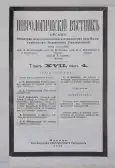Kafka. Technique and significance of cytological examination of the craniocerebral fluid. Ueber Technik und Bedeutung der cytologischen Untersuchung des Liquor cerebrospinalis. — Monatschrift für Psych. and Neurol. XXVII,414 (1910)
- Authors: Likhnitsky V.N.
- Issue: Vol XVII, No 4 (1910)
- Pages: 880-881
- Section: Abstracts
- URL: https://journal-vniispk.ru/1027-4898/article/view/104735
- DOI: https://doi.org/10.17816/nb104735
- ID: 104735
Cite item
Full Text
Abstract
The most accurate results in determining the number of formed elements in the cerebrospinal fluid are obtained, as the author notes, with the use of stained preparations. He studied the cerebrospinal fluid in a whole series of nervous and mental illnesses; most of his observations are made on progressive paralytics. With this disease, he noted the interesting fact that the number of formed elements presents significant fluctuations, and the negative results obtained in one of the studies do not give the right to draw any definite conclusions. It is also very important that the strengthening or weakening of leukocytosis does not correspond to exacerbations or weakening of the disease process, and there is no parallelism between these phenomena. So, often the condition of a progressive paralytic deteriorates sharply, and the study of the cerebrospinal fluid does not reveal an increase in the number of formed elements.
Keywords
Full Text
##article.viewOnOriginalSite##About the authors
Vitaly N. Likhnitsky
Author for correspondence.
Email: info@eco-vector.com
Russian Federation
References
Supplementary files






